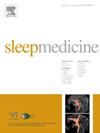Extreme pediatric obstructive sleep Apnea: Clinical Features, management, long-term outcomes and mortality
IF 3.8
2区 医学
Q1 CLINICAL NEUROLOGY
引用次数: 0
Abstract
Objectives
Extreme obstructive sleep apnea (OSA), defined by an obstructive apnea-hypopnea index (OAHI) ≥100 events/hr, presents management challenges in pediatric patients due to its severity and associated comorbidities. This study aims to review the clinical characteristics, management strategies, and outcomes in this population.
Methods
Retrospective reviewed patients aged ≤18 years with extreme OSA who underwent level 1 polysomnography (PSG) from 2010 to 2024. Logistic regression was performed to identify factor associated with surgical management, residual OSA, and revision surgery. Kaplan-Meier analysis was used to estimate 5-year mortality.
Results
Fifty patients were reviewed, with a median (IQR) age: 4.9 (1.9, 12.8) years and 32 (64 %) were male. Median (IQR) OAHI was 123.2 (112, 143.1) events/hour, with median (IQR) nadir SpO2 of 65.5 % (52.3, 74.3). The residual OSA was noted 77.8 % on follow-up PSG after initial surgery. A BMI Z-score < −2 was significantly associated with surgical management [OR 19.8, 95 % CI 1.9–21.7, p = 0.013]. A nadir SpO2 ≤ 60 % was associated with residual OSA [OR 12.5, 95 % CI 1.2–13.6, p = 0.03]. Additionally, spending more than 10 % of total sleep time with SpO2 < 90 % was associated with the need for revision surgery [OR 7.6, 95 % CI 1.1–12.4, p = 0.04]. The 5-year respiratory illness-related mortality rate was 8 % (n = 4), with higher mortality observed in children age ≤2 years (p = 0.003) and those with craniofacial anomalies or symptomatic laryngomalacia (p = 0.004).
Conclusion
Early identification of high-risk patients, vigilant care, and multidisciplinary follow-up are essential for optimizing outcomes in extreme OSA.
小儿极度阻塞性睡眠呼吸暂停:临床特征、管理、长期结果和死亡率
极端阻塞性睡眠呼吸暂停(OSA)的定义是阻塞性呼吸暂停-低通气指数(OAHI)≥100次/小时,由于其严重程度和相关合并症,在儿科患者中提出了管理挑战。本研究旨在回顾该人群的临床特征、管理策略和结果。方法回顾性分析2010 ~ 2024年接受1级多导睡眠图(PSG)检查的年龄≤18岁的重度OSA患者。进行Logistic回归以确定与手术处理、残留OSA和翻修手术相关的因素。采用Kaplan-Meier分析估计5年死亡率。结果共纳入50例患者,中位(IQR)年龄为4.9(1.9,12.8)岁,男性32例(64%)。中位(IQR) OAHI为123.2(112,143.1)事件/小时,中位(IQR)最低点SpO2为65.5%(52.3,74.3)。术后随访PSG显示77.8%的OSA残留。BMI Z-score <;−2与手术治疗显著相关[OR 19.8, 95% CI 1.9 ~ 21.7, p = 0.013]。最低SpO2≤60%与OSA残留相关[OR 12.5, 95% CI 1.2 ~ 13.6, p = 0.03]。此外,超过10%的睡眠时间与SpO2和lt;90%与需要翻修手术相关[OR 7.6, 95% CI 1.1-12.4, p = 0.04]。5年呼吸系统疾病相关死亡率为8% (n = 4),其中≤2岁儿童(p = 0.003)和颅面异常或症状性喉软化儿童(p = 0.004)死亡率更高。结论早期识别高危患者、警惕护理和多学科随访是优化极端OSA预后的关键。
本文章由计算机程序翻译,如有差异,请以英文原文为准。
求助全文
约1分钟内获得全文
求助全文
来源期刊

Sleep medicine
医学-临床神经学
CiteScore
8.40
自引率
6.20%
发文量
1060
审稿时长
49 days
期刊介绍:
Sleep Medicine aims to be a journal no one involved in clinical sleep medicine can do without.
A journal primarily focussing on the human aspects of sleep, integrating the various disciplines that are involved in sleep medicine: neurology, clinical neurophysiology, internal medicine (particularly pulmonology and cardiology), psychology, psychiatry, sleep technology, pediatrics, neurosurgery, otorhinolaryngology, and dentistry.
The journal publishes the following types of articles: Reviews (also intended as a way to bridge the gap between basic sleep research and clinical relevance); Original Research Articles; Full-length articles; Brief communications; Controversies; Case reports; Letters to the Editor; Journal search and commentaries; Book reviews; Meeting announcements; Listing of relevant organisations plus web sites.
 求助内容:
求助内容: 应助结果提醒方式:
应助结果提醒方式:


